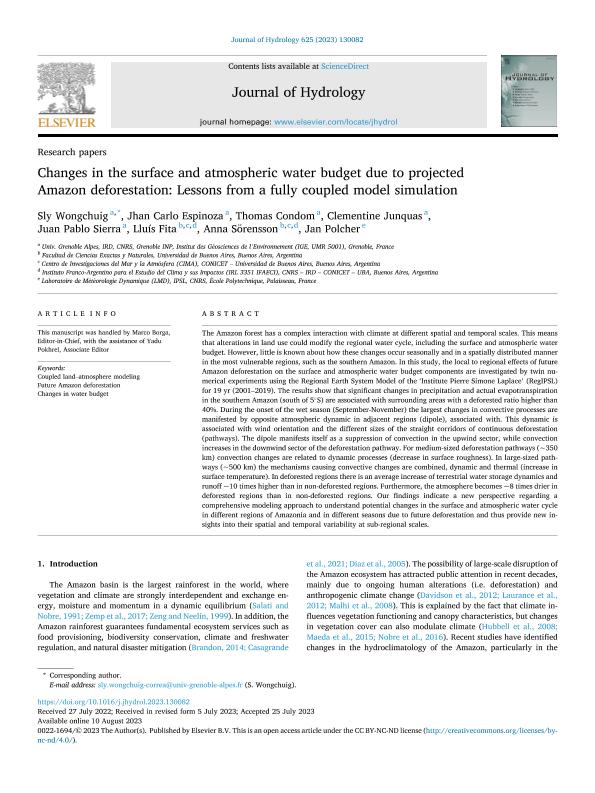Mostrar el registro sencillo del ítem
dc.contributor.author
Wongchuig, Sly
dc.contributor.author
Carlo Espinoza, Jhan
dc.contributor.author
Condom, Thomas
dc.contributor.author
Junquas, Clementine
dc.contributor.author
Sierra, Juan Pablo
dc.contributor.author
Fita Borrell, Lluís

dc.contributor.author
Sörensson, Anna

dc.contributor.author
Polcher, Jan

dc.date.available
2024-02-26T13:47:44Z
dc.date.issued
2023-10
dc.identifier.citation
Wongchuig, Sly; Carlo Espinoza, Jhan; Condom, Thomas; Junquas, Clementine; Sierra, Juan Pablo; et al.; Changes in the surface and atmospheric water budget due to projected Amazon deforestation: Lessons from a fully coupled model simulation; Elsevier Science; Journal of Hydrology; 625; 130082; 10-2023; 1-21
dc.identifier.issn
0022-1694
dc.identifier.uri
http://hdl.handle.net/11336/228410
dc.description.abstract
The Amazon forest has a complex interaction with climate at different spatial and temporal scales. This means that alterations in land use could modify the regional water cycle, including the surface and atmospheric water budget. However, little is known about how these changes occur seasonally and in a spatially distributed manner in the most vulnerable regions, such as the southern Amazon. In this study, the local to regional effects of future Amazon deforestation on the surface and atmospheric water budget components are investigated by twin numerical experiments using the Regional Earth System Model of the ‘Institute Pierre Simone Laplace’ (RegIPSL) for 19 yr (2001–2019). The results show that significant changes in precipitation and actual evapotranspiration in the southern Amazon (south of 5°S) are associated with surrounding areas with a deforested ratio higher than 40%. During the onset of the wet season (September-November) the largest changes in convective processes are manifested by opposite atmospheric dynamic in adjacent regions (dipole), associated with. This dynamic is associated with wind orientation and the different sizes of the straight corridors of continuous deforestation (pathways). The dipole manifests itself as a suppression of convection in the upwind sector, while convection increases in the downwind sector of the deforestation pathway. For medium-sized deforestation pathways (∼350 km) convection changes are related to dynamic processes (decrease in surface roughness). In large-sized pathways (∼500 km) the mechanisms causing convective changes are combined, dynamic and thermal (increase in surface temperature). In deforested regions there is an average increase of terrestrial water storage dynamics and runoff ∼10 times higher than in non-deforested regions. Furthermore, the atmosphere becomes ∼8 times drier in deforested regions than in non-deforested regions. Our findings indicate a new perspective regarding a comprehensive modeling approach to understand potential changes in the surface and atmospheric water cycle in different regions of Amazonia and in different seasons due to future deforestation and thus provide new insights into their spatial and temporal variability at sub-regional scales.
dc.format
application/pdf
dc.language.iso
eng
dc.publisher
Elsevier Science

dc.rights
info:eu-repo/semantics/openAccess
dc.rights.uri
https://creativecommons.org/licenses/by-nc-nd/2.5/ar/
dc.subject
CHANGES IN WATER BUDGET
dc.subject
COUPLED LAND–ATMOSPHERE MODELING
dc.subject
FUTURE AMAZON DEFORESTATION
dc.subject.classification
Investigación Climatológica

dc.subject.classification
Ciencias de la Tierra y relacionadas con el Medio Ambiente

dc.subject.classification
CIENCIAS NATURALES Y EXACTAS

dc.title
Changes in the surface and atmospheric water budget due to projected Amazon deforestation: Lessons from a fully coupled model simulation
dc.type
info:eu-repo/semantics/article
dc.type
info:ar-repo/semantics/artículo
dc.type
info:eu-repo/semantics/publishedVersion
dc.date.updated
2024-02-22T11:07:18Z
dc.journal.volume
625
dc.journal.number
130082
dc.journal.pagination
1-21
dc.journal.pais
Países Bajos

dc.journal.ciudad
Amsterdam
dc.description.fil
Fil: Wongchuig, Sly. Universite Grenoble Alpes; Francia
dc.description.fil
Fil: Carlo Espinoza, Jhan. Universite Grenoble Alpes; Francia
dc.description.fil
Fil: Condom, Thomas. Universite Grenoble Alpes; Francia
dc.description.fil
Fil: Junquas, Clementine. Universite Grenoble Alpes; Francia
dc.description.fil
Fil: Sierra, Juan Pablo. Universite Grenoble Alpes; Francia
dc.description.fil
Fil: Fita Borrell, Lluís. Consejo Nacional de Investigaciones Científicas y Técnicas. Oficina de Coordinación Administrativa Ciudad Universitaria. Centro de Investigaciones del Mar y la Atmósfera. Universidad de Buenos Aires. Facultad de Ciencias Exactas y Naturales. Centro de Investigaciones del Mar y la Atmósfera; Argentina. Universidad de Buenos Aires. Facultad de Ciencias Exactas y Naturales. Centro de Investigaciones del Mar y la Atmósfera; Argentina. Instituto Franco-Argentino sobre Estudios del Clima y sus Impactos; Argentina
dc.description.fil
Fil: Sörensson, Anna. Consejo Nacional de Investigaciones Científicas y Técnicas. Oficina de Coordinación Administrativa Ciudad Universitaria. Centro de Investigaciones del Mar y la Atmósfera. Universidad de Buenos Aires. Facultad de Ciencias Exactas y Naturales. Centro de Investigaciones del Mar y la Atmósfera; Argentina. Instituto Franco-Argentino sobre Estudios del Clima y sus Impactos; Argentina. Universidad de Buenos Aires. Facultad de Ciencias Exactas y Naturales. Centro de Investigaciones del Mar y la Atmósfera; Argentina
dc.description.fil
Fil: Polcher, Jan. Centre National de la Recherche Scientifique; Francia. École Polytechnique; Francia
dc.journal.title
Journal of Hydrology

dc.relation.alternativeid
info:eu-repo/semantics/altIdentifier/url/https://www.sciencedirect.com/science/article/pii/S0022169423010247
dc.relation.alternativeid
info:eu-repo/semantics/altIdentifier/doi/http://dx.doi.org/10.1016/j.jhydrol.2023.130082
Archivos asociados
